
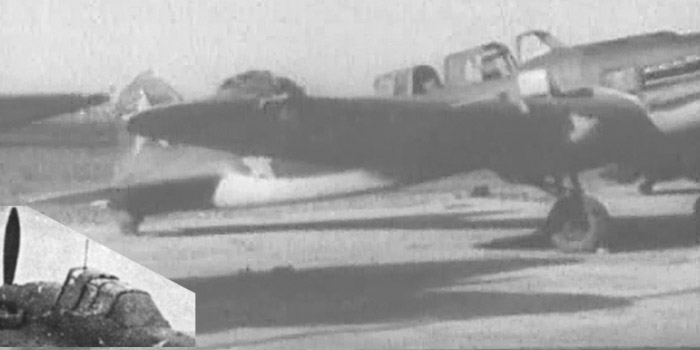
A double-command training version of the Shturmovik, the UIL-2, was commissioned to Zavod n.18 in February 1942, but the factory failed to cope and UIL-2 started to be produced in substantial number only in 1943.
These rare screenshots show what could be a very early UIL-2, probably built in 1942. The image shows many interesting characteristics:
- it is based on a single-seater with the characteristic metal wings with balances of Z.18; the fairings for the VYa-23 guns are visible, but the barrels are missing; probably the plane was armed with the couple of ShKAS only;
- the canopy is made by combining standard sliding hoods, but the windshield is unarmored and the rear part is short and without windows; on the left low, a detail of the rear of the canopy from another plane;
- the black-green camouflage follows the style of Z.18; probably the red stars had a tiny white outline as it was standard for this factory; no any bort number is visible;
- no any radio mast is visible.
A profile of this early UIL-2.
Click on the profile to see a larger 3 views drawing.
An higher resolution version of this artwork will be published for the book on Il-2 of Jason Moore.
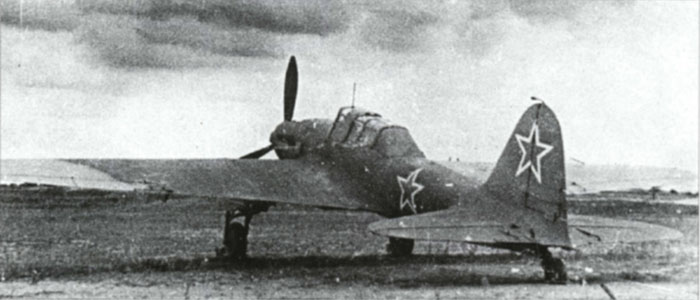
This image shows an atypical UIL-2 with an unusual camouflage of difficult interpretation.
The very angular shape of the rear section of the canopy identifies it as an early configuration., but the small discontinuity in the inclination of the leading edge identifies its wing as an arrow one. The photo gives the idea of an early UIL-2 of 1942 or 1943 revamped with arrow wings in 1944 or later.
The painting is atypical and of difficult interpretation; perhaps the fuselage and tail are painted with faded green and black, perhaps with green and dark grey; the light parts on the wing consoles could be camouflaged with AMT-1 brown .
A radio mast is visible on the windshield, possibly of the unarmored type.
Note the lack of the fairings for the VYa-23 guns; usually UIL-2s were armed with ShKAS only.
An attempt to represent the look of this hybrid plane.
Click on the profile to see a larger 3 views drawing.
An higher resolution version of this artwork will be published for the book on Il-2 of Jason Moore.
Two images of UIL-2s in the repair workshop 217 in Hissar, Tajikistan, November 1943. These planes were received by 106 ShAP.
The article in bibliography says that the plane were overhauled, but it's possible that these were old planes converted into trainers in the workshop.
The look of this plane is very characteristic: the mid and rear fuselage and the tail were painted silver; the sides of the nose (and perhaps the wingroots) were painted black, without masking; the light blue on undersurfaces was preserved; the national insignias were with white-red outline, coherent with the use of late 1943; the color of the wing upper surface is uncertain, it doesn't look shining as the fuselage, anyway it doesn't look much darker, so it could be medium grey, if not silver.
The planes are straight-winged ones, probably with metal wings (seems from the angular shape of the landing light window); the rear of the canopy was of the flush type, as for the arrow-winged UIL-2s; the aerial masts are shorter than usual.
All the visible planes have black spinner, black blades with yellow tips; one of them has a light front of the spinner, perhaps white or yellow; another one has a red trim tab on its rudder.
Source:
http://news.tajweek.tj/view/kak-v-gissare-chinili-samolety-dlya-fronta/
Thanks to Vitaliy Timoshenko


An arrow-wing UIL-2.
It's unclear if this plane is made in Z.18 as expected from UIL-2, if it's obtained with a conversion from an existing plane or what else, because the style of the tail wheel fairing and of the red stars, particularly large, are typical of Zavod 1.
Anyway, I suppose that the wing consoles are of metal type because they were prevailing on arrow-winged Il-2s..
The sliding hoods are of the partially armoured type, as those of very early Il-2s, while the windshield looks unarmoured and the rear part of the canopy is of late type, more flushed and with two small windows.
Note the deletion of VYa-23 guns and their fairings, while the ShKAS on the wings were preserved and their barrel is slightly protruding, as standard for these trainers.
The plane looks to have the VV-1 aiming probe on its nose.
The plane looks painted in green-grey-brown camo according to the second template of 1943; the red stars have the white-red outline introduced in August 1943.
(From Ilyushin Il-2 by Oleg Rastrenin)
Click on the profile to see a larger 3 views drawing.
An higher resolution version of this artwork will be published for the book on Il-2 of Jason Moore.
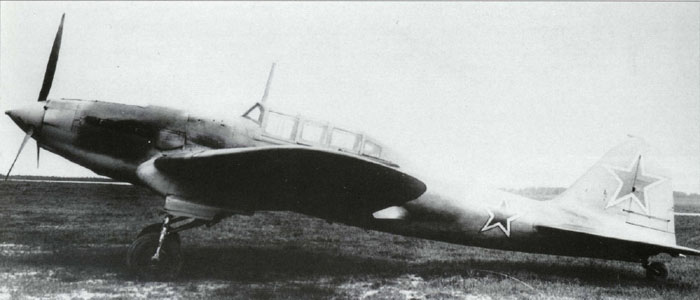
An arrow-wing UIL-2 with fully transparent sliding hoods but apparently armoured windscreen.
It shows evidence of light repainting on the rear fuselage and tail. The base scheme could have conformed to the template n.2. Such light repaintings on the rear fuselage are common in 1945; they could be a rough attempt to conform to the late 1944 grey-grey standard adding a wide blue-grey blotch (AMT-11), not following the template included on those instructions. In this case, the repainting looks even lighter than the light blue of undersurfaces, so it could be another color, ex. some light grey or blue-grey.
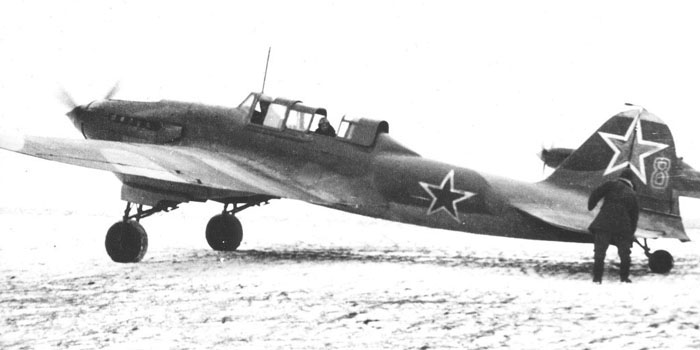
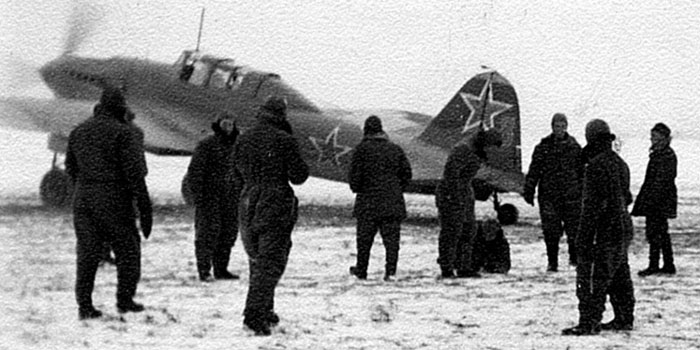
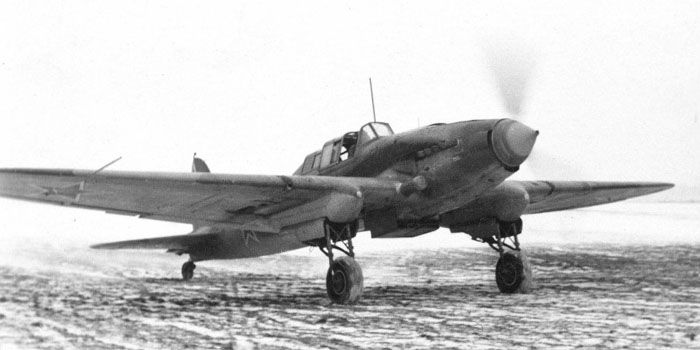
UIL-2 of Yugoslav Attack Aviation Training Center at Zemun airport, near Belgrade in December 1944, still utilizing Soviet stars.
The sliding hoods are a mix: the rear one is the fully-armored type of usual Il-2s, while the front one has the upper armor preserved, and fully transparent sides; half panel is slided back and let see the pilot directly. The windshield is armoured and the rear part is of late type with small windows.
The wing is of straight type, as one can state seeing that the hinging lines of the aileron and of the flap appear perfectly aligned; arrow wings show a step between these lines. The landing light window on the left wing looks rounded, so probably the wing was of wooden type.
Strangely, there are black traces of stain from the slots of the VYa-23 guns, but the guns themselves and their fairings aren't there; probably a smaller arm (UB or ShKAS) was installed there.
The smaller slots for the ShKAS above the leading edge don't show a protruding barrel, the ShKAS could have been removed from these positions.
(Photo from Micevskii's collection)
A profile of Red 8.
To see a larger 3-views drawing, click on the profile.
An higher resolution version of this artwork will be published for the book on Il-2 of Jason Moore.

Straight-wing White 49 of 999th ShAP on 09.05.1945. The photo is heavily retouched,anyway it shows some evidence of camouflage as usual.
On the wing there is the Divisional Commander, Major General Hotminsky.
Image via V. Timoshenko

An UIL-2 photographed in Prague in July 1945.
The use of grey instead of brown looks apparent on this photo, but it's not granted that this is an original fotocolor, it looks colorized to my eye, so it has not probative value.
(Photo from 4+ Publications-Ilyushin Il-2 Shturmovik)
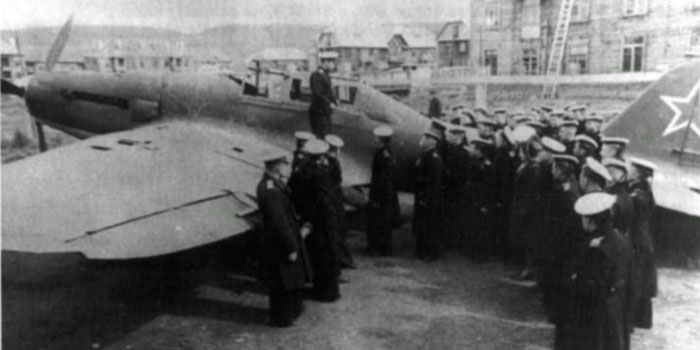
This UIL-2 in a military school in Leningrad, 1948, was repainted in overall green uppersurfaces. It presumably had a metallic rear fuselage. Seems that the transparent panels and the antenna mast have been removed for didactic purposes.
It's the only image we have on a postwar Il-2. They saw some service use up to mid 1948, presumably repainted in green as Il-10s.
Some veterans report the use of overall green liveries on Il-2s in wartime, but the photographic evidence available doesn't seem to confirm this, at least not before the war's end.
Image from Ilyushin Il-2 and Il-10 Shturmovik by Y.Gordon and S. Komissarov, ed. Crowood.
A profile of this plane.
To see a larger 3-views drawing, click on the profile.
An higher resolution version of this artwork will be published on the book on Il-2 by Jason Moore.

A photo of a Polish UIL-2, possibly White 21, probably after the war's end. The plane still features the wartime three shades camouflage, although with the characteristic non-repetitive style of Z.18 and with evidence of repaintings.
The photo seems to show a strange fairing in front of the canopy rails, but this could be a defect of the photo because it don't appear on other images of UIL-2.
The plane is only partly visible in the photo, so my attempt to draw it takes in considerations photos of other Polish Il-2s, that have often colorful spinners changing from plane to plane, and a colored cap on the tail.
Click on the profile to see a larger 3-views drawing.
An higher resolution version of this artwork will be published for the book on Il-2 of Jason Moore.
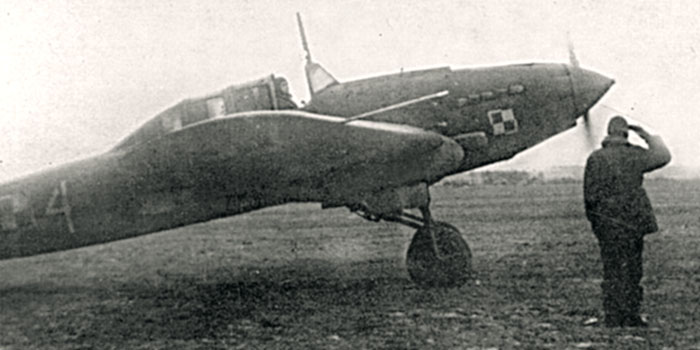
Another Polish UIL-2 'White 4', probably camouflaged as the previous one. The small Polish mark on the nose suggests that it could have been flown with red stars as national markings during the war.
from Lotnictwo z szachownica 5, via Vitaliy Timoshenko
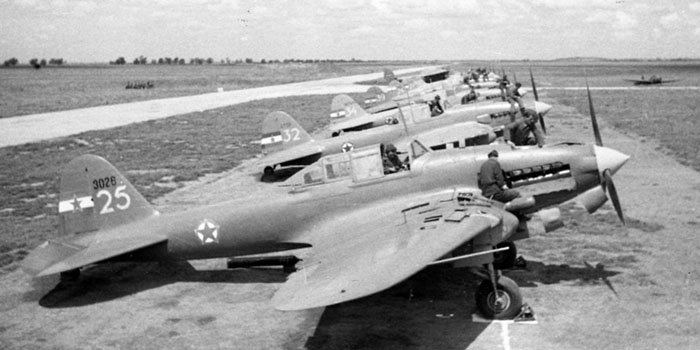
A line of Il-2 and UIL-2 of Yugoslav Air Force in 1946 or later.
Il-2s of Yugoslav Air Force wore at first Soviet 3 shades camouflage and Soviet insignias, that were converted into Yugoslav insignias in 1945. Then they wore a grey and green camouflage; then they were repainted with solid grey upper and side surfaces.
This plane has still a wooden rear fuselage; later the wooden rear fuselages were replaced with metallic ones built locally by Ikarus for better durability.
The UIL-2 in first position shows unarmoured sliding hoods with armoured windshield.
The first plane is noticeable also because the blue and red of its markings are by far less contrasting than those of the planes on the background.
Note that this plane has the wings from a singleseater built in Zavod 18, as recognizable for the flushed gun fairings; the guns were not installed, only the smaller ShKAS machine guns. Perhaps this plane was converted as a trainer from a normal Il-2.
It's unclear if the plane had rocket rails; they appear on a photo of another Yugoslav UIl-2.
A drawing of white 25.
Click on the profile to see a larger 3 views drawing.
An higher resolution version of this artwork will be published for the book on Il-2 of Jason Moore.






